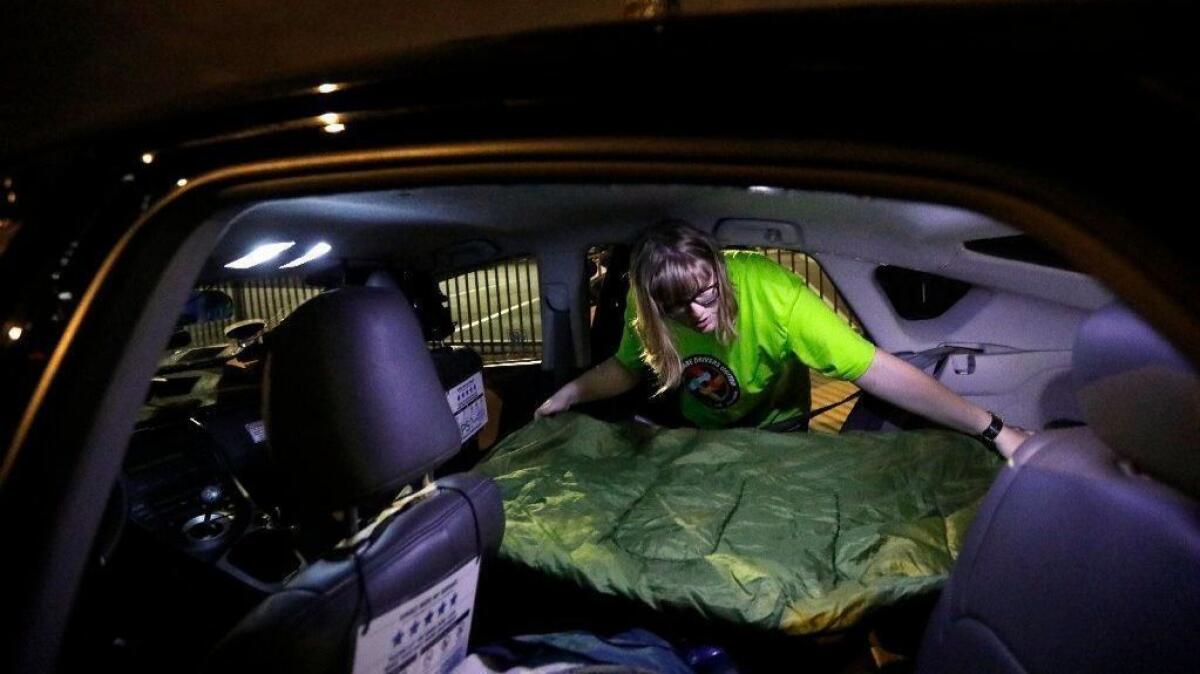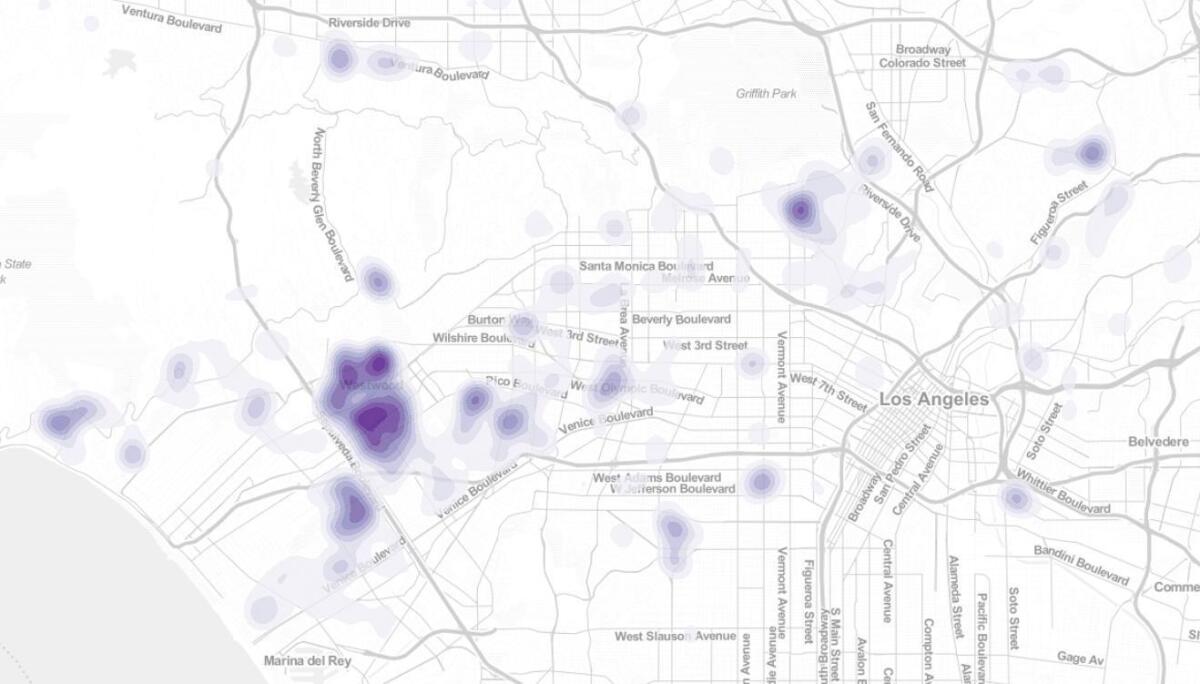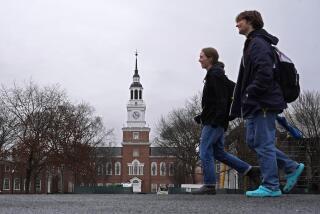Newsletter: Essential California: When the Lyft you drive is also your home

Good morning, and welcome to the Essential California newsletter. It’s Tuesday, May 21, and I’m writing from Los Angeles.
Los Angeles Times business reporter Johana Bhuiyan has often written about the human costs of the cheaply priced gig economy. Yesterday, she published a major investigation on Lyft’s Express Drive program, which rents cars to drivers.
Both Lyft and Uber offer short-term car rental agreements to people, including those who might have poor credit or are desperately in need of a flexible stream of income. But drivers who rent through Lyft pay a premium and earn less than other ride-share drivers. Strapped to make ends meet, some even sleep in their cars.
I talked to Johana about the burdens shouldered by individual drivers, and what it says about the gig economy.
Why do Uber and Lyft need programs like Express Drive to recruit new drivers?
A little more than 60% of drivers stop driving for either Uber or Lyft within six months. It could be because they no longer need to do it anymore, or because the rates are too low, or any number of reasons. So, the pool of new drivers that Uber and Lyft can tap into is very limited in the U.S.
Both companies focused a lot on just getting new drivers and spent less time on keeping them around. Offering car rental programs allows them to be creative about opening up that really limited pool of drivers in the U.S.
Why is that pool so limited?
A lot of people who either qualify to drive for Uber or need to drive for Uber — those demographics — have already started to drive for Uber and Lyft and then decided not to do it anymore. There aren’t a ton of new drivers for Uber and Lyft to recruit anymore, so they have to focus on retaining them.
Who gets targeted for these programs? Is it people who might not have otherwise qualified to drive for Uber or Lyft?
It’s people who don’t have a car at all or people who have a car but don’t meet all of the company’s requirements, which include how old the car is, things like that.
Your story delves into the higher costs of these programs that might not be obvious. What do those look like?
In some markets, the rent per week starts at $219. But what a lot of drivers end up paying is about $240, including taxes and fees. So it’s just under $1,000 a month, if you’re paying $240 a week.
The company says that insurance is included in that cost, but drivers who rent with Lyft are also being paid less per mile than drivers who use their own cars.
The other thing with ride-sharing apps is that a lot of drivers do multiple apps to come up with a pretty steady income. But if you rent a car through Lyft or Uber, you are not allowed to work for more than one service. So you can only drive for Lyft or you can only drive for Uber. Even if the pay was on par with what they were making before, they’re limited in how they can make their money.
Some of the drivers you wrote about are actually living in their cars. How does that shake out?
Due to extenuating circumstances, some of these drivers have resorted to sleeping in their cars. At least one of them got a second job and is now able to afford a room in a boardinghouse in Hollywood, but before that he was sleeping in his car.
So, this vehicle that he’s paying $240 a week for and is being paid less [than a driver who wasn’t renting from the company] to drive is not just his income, it’s also his home. The difficult thing is that they’re just not making enough to save.
Lyft puts a hold on your account for the cost of your [car] rent. So, until you make enough rides to cover that rent, you don’t have any income. Typically drivers spend the first two days of the week driving to cover that rent. It’s not until Tuesday or Wednesday that they actually have money that they can withdraw from their account. For drivers who are struggling and don’t have a ton of income or anything in their bank, that’s two days where they have to overdraw their bank accounts for gas money. That’s two days where they have to figure out what meals they can and cannot eat.
Lyft also imposes a few conditions and requirements that makes it feel like there’s this looming threat of losing the vehicle. And obviously for someone who’s living in the car, that’s pretty daunting.
[Read “Lower pay and higher costs: The downside of Lyft’s car rental program” by Johana Bhuiyan]
What do these stories say about the gig economy and gaps in the social safety net?
It says a lot of things. It’s interesting because Lyft and Uber both pitch themselves as this, you know, part-time solution for people who just need cash on the side or supplementary income. They constantly say that more and more of their drivers are part-time…. And that’s kind of this protection for them, because earnings are decreasing in a lot of markets as they cut the prices for all drivers. So they go, ‘Well, this is not something that drivers are completely relying on for all of their income.’ But then these programs essentially incentivize you to work full-time.
There are a lot of upsides to driving for Lyft and Uber. But there’s a lot more downside when you are driving it full-time and are paying the premiums to drive for the company.
You cover the tech beat really differently than most, with a focus on how regular people are affected by these changing technologies. What’s your reporting philosophy?
My entire focus at the L.A. Times is accountability. My north star has always been keeping the powers that be accountable to the public. That’s always how I’ve covered the companies that I write about.
What really matters is how this tech and innovation is affecting real people. There are forms of innovation that might be good for a certain demographic, but are also continuing to marginalize communities that are already really disenfranchised. I think it’s important to focus on how these corporations are affecting actual human beings.
And now, here’s what’s happening across California:
TOP STORIES
What the heck is going on with the Lakers? Magic Johnson, who abruptly resigned in April, went on national television Monday morning to make public his criticism of Lakers general manager Rob Pelinka and to set the record straight while bringing to light problems that need to be addressed within the Lakers’ organization. Los Angeles Times
But the Lakers had initially intended for Monday to be all about new coach Frank Vogel, who was introduced at a news conference. In a column, Los Angeles Times sportswriter Dylan Hernandez writes that Vogel showed an ability to “roll with the punches” during an introduction that certainly didn’t go as planned. Los Angeles Times

Nativo Lopez, a pioneering and polarizing Latino leader in Orange County, has died at 68. Los Angeles Times
Get the Essential California newsletter »
L.A. STORIES
There are 15 candidates running to represent the west San Fernando Valley in a special election for an L.A. City Council seat, and reporter Elizabeth Chou spent time with each of them to write these profiles. Los Angeles Daily News
Someone stole the neon sign from Good Luck Bar, a recently closed and much-loved Los Feliz watering hole. Bar owners say they don’t want to prosecute, they just want their sign back. Eater LA
In today’s Column One, a Los Angeles woman with a disability found a way to succeed in school — a far cry from illegal schemes by wealthy parents in the college admissions scandal. Los Angeles Times
It’s jacaranda season in Los Angeles, which means the streets have exploded in a glorious, purple haze. My colleague, reporter Matt Stiles, made this fantastic heatmap showing the density of jacaranda street trees around Los Angeles. See below for the best jacaranda-seeking spots.

Plus, here’s a story I wrote a few years ago that goes deep on the history of jacaranda trees and the woman who brought them to Southern California. LAist
Your support helps us deliver the news that matters most. Subscribe to the Los Angeles Times.
IMMIGRATION AND THE BORDER
A 16-year-old Guatemalan boy died in Border Patrol custody in Texas. He is the fifth migrant child to die after being apprehended at the U.S. border since December. Associated Press
A cross-border Baja California politician who has served in elected office in both the U.S. and Mexico is now Baja California’s leading candidate for governor. San Diego Union-Tribune
POLITICS AND GOVERNMENT
Ramifications of the Trump administration’s escalating trade war with China are being felt in California:
California fruit and nut farmers are pleading for tariff relief. State lawmakers have asked the U.S. Department of Agriculture to make more specialty crops, such as grapes and walnuts, eligible for a trade relief program that gives some farmers direct payments to offset a loss of their income. Sacramento Bee
The effects of increased Chinese tariffs on U.S. wines are being felt in California wine country. San Luis Obispo Tribune
The ports of L.A. and Long Beach, where the bulk of U.S. imports from Asia are delivered, have also been affected. Los Angeles Business Journal (More on how the ports could be affected from CNBC)
However, in Gilroy — a small city in the Santa Clara Valley known as the “garlic capital of the world” — growers are singing a very different tune. Ken Christopher of Christopher Ranch, the nation’s largest commercial garlic grower, said he was “elated” when news of the tariffs was announced: His company stands to gain from a 25% tariff the Trump administration imposed on Chinese garlic and other goods. San Francisco Chronicle
CRIME AND COURTS
Adult-film actress Stormy Daniels has agreed to settle the last of three lawsuits that her former attorney Michael Avenatti filed in the scandal stemming from her alleged one-night stand with Donald Trump. Los Angeles Times
The Supreme Court refused to block an excessive force suit against the city of Newport Beach, clearing the way for a jury to decide whether the police are liable for shooting and killing a mentally ill young man who came running at them holding a pair of scissors. Los Angeles Times
The legal battle between Sriracha maker Huy Fong Foods and a Ventura County jalapeño farm is heating up. Los Angeles Times
Eight parents charged in the college admissions scandal are expected to plead guilty this week. Los Angeles Times
THE ENVIRONMENT
Wildfires don’t discriminate between wealthy and poorer communities. But recovery processes can. Here’s a look at the disparate timeframes of rebuilding after fires in California’s wine country (the 2017 North Bay fires) and the state’s poorest county (the 2015 Valley fire), shown by data. High Country News
CALIFORNIA CULTURE
Top live-streamers on Twitch can get $50,000 an hour to play new video games online. “Having celebrity streamers play games is an important part of the business,” a gaming chief executive said. Wall Street Journal
One of the top professional esports players in the world is suing his gaming organization, accusing it of restraining his business opportunities and taking too large a chunk of his earnings. The lawsuit, which may portend larger industry fights to come, argues that esports players’ representatives should be regulated like the agents of film and TV stars. The Hollywood Reporter
Some Sonoma County vintners have found a unique approach to pest control: barn owls. Santa Rosa Press Democrat
Sure, globalism has flattened everything and Amazon is killing your lovely local bookstore as we speak. But don’t despair completely — weirdness and hyper-specificity still reign at San Francisco’s 13 best niche retail shops. SFist
How marijuana legalization changed the Northern California community of Humboldt County. The New Yorker

“Cake is my medium.” The story behind all those colorful shag rug-style cakes on Instagram. Los Angeles Times
CALIFORNIA ALMANAC
Los Angeles: mostly sunny, 65. San Diego: cloudy, 63. San Francisco: rain, 58. San Jose: rain, 60. Sacramento: rain, 64. More weather is here.
AND FINALLY
Today’s California memory comes from Tom Ozinga:
“In the summer of 1959, this college senior from Grand Rapids, Mich., was a junior high camp counselor at Mount Hermon [in the Santa Cruz Mountains]. I was amazed at the low humidity and cool nights under blankets in the cabin — after 90-degree days. So unlike Michigan, with its many humid summers. On days off, I usually walked a mile to the little town of Felton, enjoyed a cold beer at the only pub and strolled through the awesome grove of redwoods nearby. I hope those friendly giants are still there.”
If you have a memory or story about the Golden State, share it with us. (Please keep your story to 100 words.)
Please let us know what we can do to make this newsletter more useful to you. Send comments, complaints, ideas and unrelated book recommendations to Julia Wick. Follow her on Twitter @Sherlyholmes.







